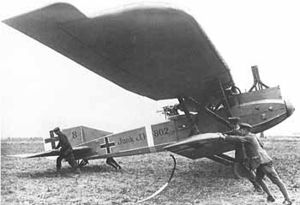
The Fokker D.VII was a German World War I fighter aircraft designed by Reinhold Platz of the Fokker-Flugzeugwerke. Germany produced around 3,300 D.VII aircraft in the second half of 1918. In service with the Luftstreitkräfte, the D.VII quickly proved itself to be a formidable aircraft. The Armistice ending the war specifically required, as the fourth clause of the "Clauses Relating to the Western Front", that Germany was required to surrender all D.VIIs to the Allies. Surviving aircraft saw much service with many countries in the years after World War I.
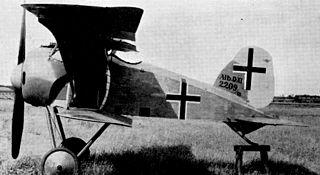
The Idflieg designation system was used to classify German heavier-than-air military aircraft from the early days of the Fliegertruppe/Luftstreitkräfte to the end of World War I. The system evolved during this period as new classes of aircraft came into use.

The AEG G.IV was a biplane bomber aircraft designed and produced by the German aircraft manufacturer Allgemeine Elektrizitäts-Gesellschaft. It saw action during the First World War with the Luftstreitkräfte.

The AEG J.I was a German biplane ground attack aircraft designed and produced by the German aircraft manufacturer Allgemeine Elektricitäts-Gesellschaft. It was a mission-specific derivative of the AEG C.IV reconnaissance aircraft.
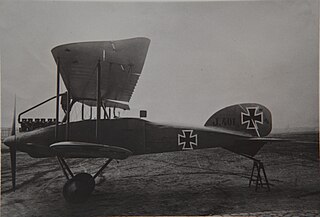
The Albatros J.I was a German armored ground attack airplane of World War I, produced in 1918.

The Albatros J.II was a German single-engine, single-seat, biplane ground-attack aircraft of World War I.

The Hansa-Brandenburg W.29 was a German two-seat fighter floatplane which served in the closing months of World War I with the Imperial German Navy's Naval Air Service from bases on the North Sea coast. In concept the aircraft was a monoplane version of the biplane Hansa-Brandenburg W.12, although there were many structural differences between the two.
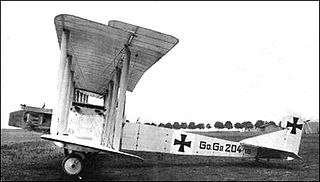
The Gotha G.II series was a heavy bomber used by the Luftstreitkräfte during World War I.

The Gotha G.IV was a heavy bomber used by the Luftstreitkräfte during World War I. It was the first mass-produced relatively large airplane.
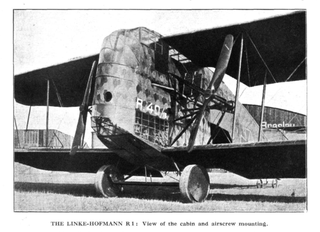
The Linke-Hofmann R.I was a heavy bomber aircraft designed and built by the German company Linke-Hofmann during World War I. Only four were built and the type never saw service with the Luftstreitkräfte.

The Junkers J 1, nicknamed the Blechesel, was an experimental monoplane aircraft developed by Junkers. It was the first all-metal aircraft in the world. Manufactured early on in the First World War, an era in which aircraft designers relied largely on fabric-covered wooden structures braced with wires, the J 1 was a revolutionary development in aircraft design, making extensive use of metal in its structure as had already been done and in its outer surface.

The DFW R.III was a German bomber aircraft designed during World War I, but which had not yet been built when the end of the war led to the project's cancellation. Conceptually similar to DFW's preceding R.I and R.II designs, the R.III was to have been a much larger aircraft, powered by eight engines. As with the previous designs, these were to be housed inside the fuselage, driving propellers by long driveshafts. In the R.III design, however, these propellers were to be mounted on a nacelle in the interplane gap. Each end of this nacelle would carry two co-axial propellers, each driven by a separate engine. Had it been built, the R.III would have been the largest aircraft in the world at the time.

The LFG Roland D.II was a German single-seat fighter of World War I. The type was manufactured by Luftfahrzeug Gesellschaft, and also by Pfalz Flugzeugwerke under license.

The Junkers D.I was a monoplane fighter aircraft produced in Germany late in World War I, significant for becoming the first all-metal fighter to enter service. The prototype, a private venture by Junkers named the J 7, first flew on 17 September 1917, going through nearly a half-dozen detail changes in its design during its tests. When it was demonstrated to the Idflieg early the following year it proved impressive enough to result in an order for three additional aircraft for trials. The changes made by Junkers were significant enough for the firm to rename the next example the J 9, which was supplied to the Idflieg instead of the three J 7s ordered.

The LFG Roland D.I was a fighter aircraft produced in Germany during World War I. It was a single-seat aircraft based originally on the Roland C.II two-seat reconnaissance type. It shared its predecessor's unusual design feature of having a deep fuselage that completely filled the interplane gap, but in comparison, the fuselage was much sleeker. While the C.II's appearance had earned the Walfisch ("Whale"), the D.I became known as the Haifisch ("Shark"). The I-struts that had been used to brace the C.II's wing were replaced by more conventional struts. Other changes to the wing included the removal of stagger from the design and the introduction of slight sweepback.

The Zeppelin-Lindau Rs.I was a large three-engined biplane flying boat designed by Claudius Dornier and built during 1914–15 on the German side of Lake Constance. It was destroyed in a storm.
The Sopwith Buffalo was a British armoured fighter/reconnaissance aircraft of the First World War. A single-engined biplane, two examples of the Buffalo were built by Sopwith to carry out reconnaissance missions low over the trenches while protected against machine-gun fire from the ground, but no production followed, with the end of the war removing the need for such an aircraft.

The Zeppelin-Lindau Rs.II was a biplane flying boat, designed by Claudius Dornier as a follow-on to his Zeppelin-Lindau Rs.I and built during 1914–1915 on the German side of Lake Constance. Initially this aircraft was powered by three engines mounted inside the hull driving three pusher propellers via gearboxes and shafts. The later version was powered by four engines in two push-pull nacelles mounted between the wings.

The Zeppelin-Lindau Rs.III was a large four-engined monoplane flying boat designed by Claudius Dornier and built during 1917 on the German side of Lake Constance at the Zeppelin-Lindau works.

The Zeppelin D.I, or Zeppelin-Lindau D.I or Zeppelin D.I (Do), as named in German documents, also sometimes referred to postwar as the Dornier D.I or Dornier-Zeppelin D.I, for the designer, was a single-seat all-metal stressed skin monocoque cantilever-wing biplane fighter, developed by Claude Dornier while working for Luftschiffbau Zeppelin at their Lindau facility. It was too late to see operational service with the German Air Force (Luftstreitkräfte) during World War I.
